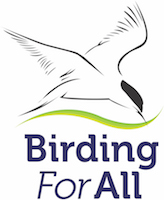The bulk of this article appeared a while back in Birdwatching Magazine – it gives a good flavour of what Birding For All is and is trying to do. The one big change since I wrote it is that the RSPB seems to be committed at the top and bottom to take this issue really seriously. There is also some sterling work going on at County Reserves and the like. However, whilst some do nothing there are others who think they have done all that is needed but have an over narrow idea of disability and think that responding to the needs of wheelchair users is all that is needed. Only a small percentage of disabled people need to use wheelchairs and whilst everything should be done to make reserves accessible to them, many more people would benefit from measures that allow people with mobility problems to rest at regular [pretty short] intervals. Having a bench every couple of hundred yards is not only terrific to use but also give people confidence so they can set off on a trail knowing that when they need it rest is at hand. What is more there are a great many people who enjoy birds but have sensory problems and more sites need good signage and loop systems in interpretation centres and so forth.
I hope people feel able to respond to the following…
All Birds Are Not Roadrunners!
Like a horses head left in your bed by Don Corleone an invitation from the editor to ride your hobby horse in the pages of Birdwatching is an offer you can’t refuse! But its hard to launch into my normal rant when seeds sown over the last four years by the disabled birders association are, at long last, taking root; we have seen tremendous progress where we have had most input. Being approached by the RSPB Director of Operations at this year’s British Bird Fair speaks volumes about our largest service provider’s current willingness to listen and address shortcomings.
However, providers’ strategic thought takes time to filter down and there are still many more reserves with poor access than barrier-free ones. Because a number of dba activists live in the South East it is becoming a real template for other areas. The RSPB reserves at Dungeness, Elmley, Northward Hill and Cliffe have made, or are making, great progress. English Nature and County Trust sites at Oare, Stodmarsh and Grove Ferry are all listening and progressing too – but do not suppose that the battles are won elsewhere, let alone the war!
Let me explain what us bolshie birders with limited mobility want. Firstly, we speak about “barrier-free” access. Simply, this means that there should be nothing that is hard for a person to walk or wheel on, up, over or through. Service providers should always be clear why they put up a gate or fence, a step or a steep incline. If you are trying to keep out stock then a cattle grid may well be easier for a wheelchair user to negotiate than a gate with an unreachable lock. Why are gravel paths used not compacted surfaces, why steps not ramps, etc.?
Most of this is about that rarest of commodities – common sense. Anyone who has walked across a shingle beach can appreciate what it must be like to try and wheel along a gravel path. Anyone who has pushed a pram will know how difficult even short flights of steps are, let alone a kissing gate [there ARE kissing gates that will let a horse and wheelchair pass but keep out motorbikes!]. Every aspect of design needs to be addressed mindful of this watchword. I always liken facilities to shoes… no one would find it acceptable if all shoes were size 10 Doc Martins; many prefer size five stilettos! The equivalent is a hide suitable only for a fit six-footer! “Access for all” should be a requirement otherwise birding is just for the fit elite.
And, fellow birders, whilst I’m in mid rant please bear in mind that the bloke who passes you in a car en route to a hide is not a lazy fat fellah, but someone who cannot walk it – unless of course its me and then it is a lazy fat disabled bloke! A couple of years back I was approached by at the BBF by a German tour company who slightly misunderstood the relationship between my Fatbirder persona and the dba as he offered to run a trip for Fat Birders who could not walk far.] Setting up the dba has proved fruitful and fun too. Our trips overseas have taught me that simplicity of design is king – we had far fewer problems in Kenya or India than we did Canada and Australia because all facilities were more basic and simple and so much easier to use.
Thinking Inside the Box
In discussion with those responsible for planning the new RSPB reserve at Cliffe I made the plea to look at access when designing reserves not later in the process. The other day I had a call as the reserve has reached an advanced stage in planning and it looks like the RSPB are going to break new ground with an exciting access initiative – I wish I could say more but everything awaits funding. Of course the needs of the birds are paramount and, of course, there are sometimes habitat and topographical constraints, but within those strictures visitor needs should be considered in parallel so that access is designed in, rather than an afterthought. In the UK reserves are most often a box shape surrounded by a path with public facilities at one end; rarely are visitor facilities [like car parking and hides] central so people view outwards as in overseas reserves where people stay in compounds or vehicles to avoid being dinner! Walkers disturb birds more than vehicles do.
Feet and Wheels
Only a small percentage of disabled people use wheelchairs; they are not the only group with needs. Sensory impairment, such as hearing loss, is far commoner so centres and trails should take this into account. As we age so our hearing and vision decline as does our ability to walk long distances over difficult terrain. Mobility is restricted and distances an issue; if there are benches every 100 to 150 meters range is greatly enhanced for many. There are lots of people like me who, on a bad day have trouble just getting around the house but who on good days can walk a few hundred yards. If there are benches to rest on here and there then I can get around a 1 kilometer circuit on a good day, without them I recon I need to turn back after about 150 yards as 300 yards is a limit before the pain gets too much or my legs seize up. The dba is always happy to advise on access at any stage of reserve development.
The Good, the Bad and the Ugly
I apologise for the southeastern bias in the following but our most active members tend to be located there – others please note as we have a printable pro-forma on the dba website so you can assess the access at your reserve and let us share it with the world.
A quick survey amongst a handful of dba members revealed that RSPB Titchwell, NWT Cley Marsh, NWT boardwalk at Holkham, WWT Welney and Lea Valley Park are good for wheelchair users. I would add much of the RSPB Reserve at Dungeness where blue badge holders can drive to hides setting down on concrete pads, but simple strategically placed benches would help more. Much of Elmley RSPB is birdable from the car; access being allowed all the way to the hides on the floods. Oare [near Faversham in Kent] is getting there with especially created parking to view scrapes giving priority to disabled drivers. Viewing ramps [with benches such as at Grove Ferry, Kent] are a real boon to all birders with limited mobility as one can sit at the top of a shallow gradient mound and see well for hundreds of meters.
Our treasurer said “I have been going to Minsmere for 25 years and though its a rugged push around I’ve accepted the effort because at least the paths were pushable”. What most people do not know is that disabled people have always been allowed to drive some of the tracks to get them closer to hides but not all hides are accessible. Now, of course, they even have a buggy or two available for the ‘hard of walking’. Sandwich Bay Bird Observatory has made great efforts to overcome the total lack of disabled access to the major scrape [unchangeable because of the landowner’s restrictions] by creating a new one which is already attracting terrific birds. The accommodation at the obs is fully adapted as is the car park and viewing ramps and boardwalks are planned. The attitude is a model many could learn from.
As for the bad, Brian said “It’s difficult to select the worst reserve but most memorable recently was Rutland Water! Some of the paths & hides were quite good, but on other sections paths were really bad. A few hundred yards were laid with chunky, chalky stone and I struggled to get over it to the other hides”. This was a while ago and I do know that those in charge are trying hard to put this right and have even replaced some paths on the reserve.
The list of poorly accessible reserves is too long to include – a visitor to the dba BBF stand said that he could not think of one reserve in Worcestershire that was easily accessible by wheelchair! He is not alone in thinking his county is the worst! But rather than me telling you what I think is ugly and unacceptable you tell me – look at the dba website and mail me your horror stories – I will be more than happy to put our growing lobby at your disposal. It is no longer acceptable to give excuses why disabled people, elderly, children, expectant mothers et al cannot pursue their hobby, any more than it is to deny reasonable access to birders in general so long as the birds are always put first!
For printable access forms, how to join and where to go, see: www.disabledbirdersassociation.co.ukplease join and help [able-bodied welcomed too!] For further site info see: www.fatbirder.com and for reports on our overseas trips see: www.birderstravel.com





